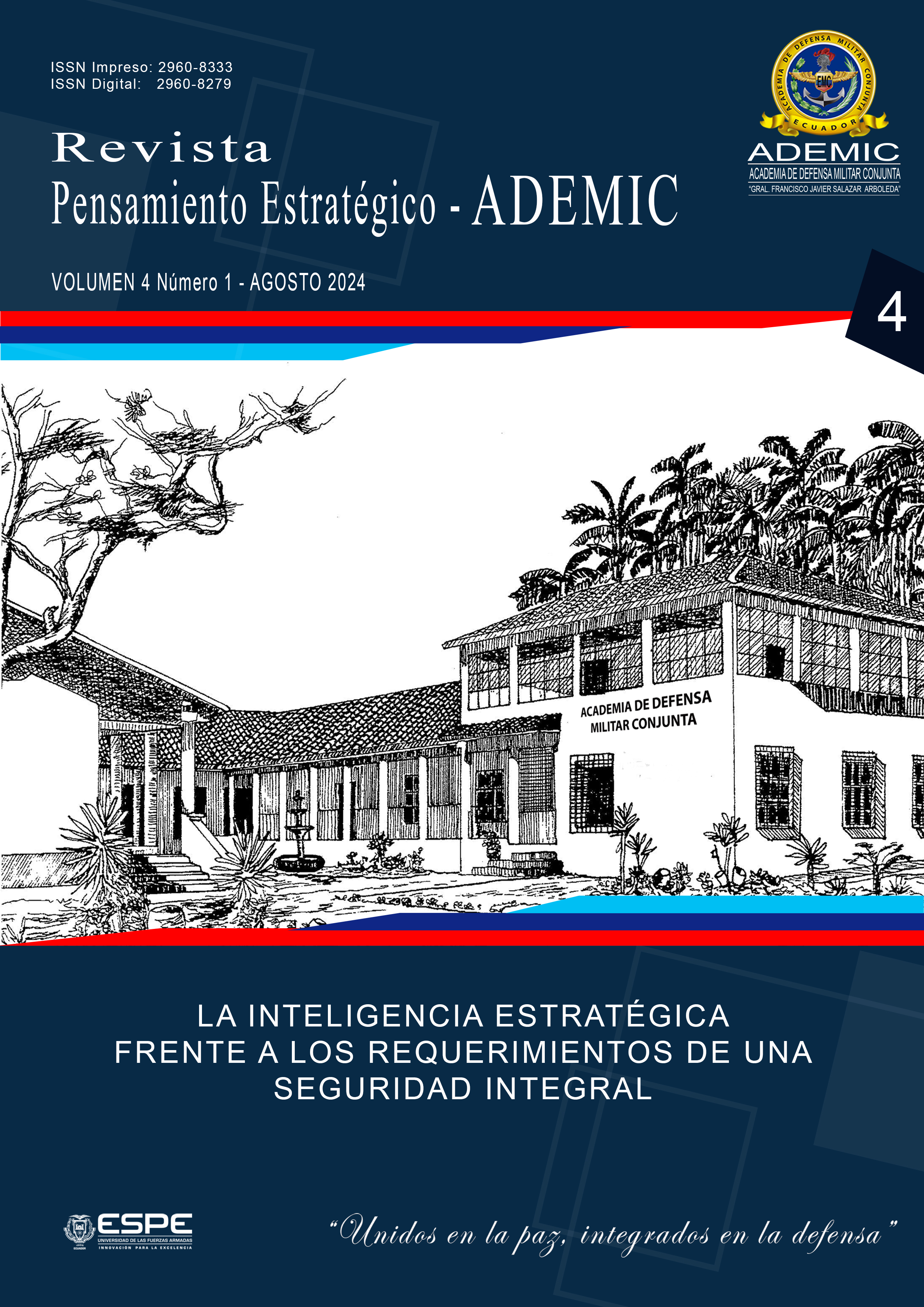DINÁMICAS EN TENSIÓN DE LA SEGURIDAD INTERNACIONAL: MULTICRISIS 2024
Main Article Content
Abstract
El presente artículo enuncia las principales variables que están modificando los equilibrios globales geopolíticos y geoeconómicos entre 1990 y 2024, así como la rivalidad entre Estados Unidos y China. Se da una crisis de los procesos de regionalización forjados a finales del siglo XX, incrementándose las tensiones entre las naciones. Otra variable es el desgaste de los organismos internacionales como mediadores de los conflictos, como la ONU. Por ello, han aparecido graves conflictos militares inter estatales e intra estatales, provocando crisis humanitarias como la guerra civil de Siria, la agresión de Rusia a Ucrania, y el conflicto entre Hamas e Israel, entre otros. Se toman en cuenta tres variables macro: la población, la economía y el poder militar de los países líderes del sistema internacional. A nivel militar, ha vuelto a aparecer la variable nuclear como síntoma de la descomposición de las relaciones entre las naciones. En las conclusiones se mencionan tres escenarios: el negativo, regresando al realismo en un mundo crecientemente peligroso; el positivo, con el retorno a mecanismos de cooperación internacional; y el probable, mediante la cooperación limitada en las relaciones entre las naciones y que puedan mantenerse mecanismos de solución de controversias. Se menciona que el mundo oscila en un péndulo entre el multilateralismo y la anarquía global.
Downloads
Article Details

This work is licensed under a Creative Commons Attribution-ShareAlike 4.0 International License.
How to Cite
References
Barragán M. y Sribman A. Coords. (2024), Geopolítica de América Latina. Cambio de ciclo y
multipolaridad, CIDOB, Barcelona.
Blackwill R. and Fontaine R. (2024), Lost Decade: The U.S. Pivot to Asia and the Rise of Chinese
Power, Oxford University Press, 2024, 480 pp.
Bustelo, P. (2010) Chindia. Asia a la conquista del siglo XXI, Real Instituto Elcano, Tecnos Editorial,
Madrid.
Crocker, C. et. al. (2021). Diplomacy and the Future of World Order. Georgetown University Press,
Washington.
Curzio, E. (2023). La invasión a Ucrania: Polaridades y Perspectivas. Revista Mexicana de Política
Exterior, n.º 127 (diciembre): https://revistadigital.sre.gob.mx/index.php/rmpe/article/
view/2642.
Davies, Shawn; Therese Petterson y Magnus Oberg (2023) “Organized violence 1989-2022 and
the Return of Conflicts Between States?”, Journal of Peace Research 60(4): 691-708.
Department of Defense (2013). DIRECTIVE NUMBER 5105.62, April 24, https://
www.esd.whs.mil/Portals/54/Documents/DD/issuances/dodd/510562p.
pdf?ver=2019-01-14-090613-313
Ediciones en Lenguas Extranjeras (2019), China, Beijing.
Fernández D. (2023). Historia de la Unión Europea: De los orígenes al Post-Brexit. Universidad
Autónoma de Madrid, Madrid.
FES Asia (2023), India in the geopolitics of Asia: Four scenarios and policy options, https://asia.fes.
de/news/india-geopolitics
Gates, R. (2024), The Dysfuntional Superpower. Can a Divided America Deter China and Russia?,
Foreign Affairs, July-August.
Ghotme, R. y García, N. (2016). Los refugiados sirios como “problema” de seguridad regional.
Estudios de Asia y África, Vol. 51 No. 2, El Colegio de México. https://doi.org/10.24201/eaa.v51i2
Haug, S., Braveboy-Wagner, J. y Maihold, G. (2021). The ‘Global South’ in the study of world
politics: examining a meta category. Third World Quarterly, Volume 42.
International Institute for Strategic Studies (2023). The Military Balance 2023, London.
Hurrell, A. (2018). “Beyond the BRICS: Power, Pluralism, and the Future of Global Order”, Ethics
and International Affairs, Vol. 32, No. 1.
Kaplan, Robert (2012) The Revenge of Geography. What the map tells us about coming conflicts
and the battel against fate, Random House, New York, 2012.
Kattelman, K. (2020). Assessing success of the Global War on Terror: Terrorist attack frequency
and the backlash effect. Dynamics of Asymmetric Conflict, 13(1), pp. 67-86. https://doi.org/
1080/17467586.2019.1650384
Kennedy, P. (1993). Hacia el Siglo XX. Un exhaustivo análisis de las fuerzas y tendencias que
perfilarán el nuevo siglo. Plaza & Janes, Barcelona.
Martínez, R. (coord.) (2022). El papel de las Fuerzas Armadas en la América Latina del siglo XXI,
Centro de Estudios Políticos y Constitucionales, Madrid.
Mills, Greg, et al. (2017) Making Africa Work. A Handbook of Economic Success, NB Publishers,
Cape Town.
Narang, V. (2022). Seeking the Bomb: Strategies of Nuclear Proliferation, Princeton University
Press, Princeton, 400 pp.
Pandya, A. (2023). The U.S. Doesn’t Understand Indian Diplomacy. The National Interest.
https://nationalinterest.org/feature/us-doesn%E2%80%99t-understand-indian
diplomacy-209942
Reichmann, K. (2019). Here’s how many nuclear warheads exist, and which countries own them.
Defense News. https://www.defensenews.com/global/2019/06/16/heres-how-manynuclear-warheads-exist-and-which-countries-own-them
Rudd, K. (2022). The Avoidable War: The Dangers of a Catastrophic Conflict Between the US and
Xi Jinping’s China. USA: Public Affairs.
Sanahuja, J.A., (2022) Pp 41-73 José Antonio, “Guerras del interregno: la invasión rusa de
Ucrania y el cambio de época europeo y global, en Manuela Mesa (coord.) Cambio de
época y coyuntura crítica en la sociedad global. Anuario 2021-2022Fundación Cultura de
Paz, Madrid, 2022.
Sánchez, C. (2023) “La estrategia de seguridad nacional china”, en Estrategias de Seguridad
Nacional: La competencia entre grandes potencias, Documento de Investigación
/2023, Instituto Español de Estudios Estratégicos, www.ieee.es/Galerias/fichero/docs_
investig/2023/DIEEEINV02_2023_EstrategiasdeSeguridad.pdf
Serrano, M. (1996). El Tratado de Tlatelolco; la contención de la amenaza nuclear en América
Latina”. Revista Mexicana de Política Exterior, No. 50, primavera- verano.
Sixsmith, M. (2024). Putin and the Return of History: How the Kremlin Rekindled the Cold War,
Bloomsbury, London.
The Dialogue (2024) The Venezuelan-Guyanese Border Crisis—The Essequibo Controversy,
Feb. 13, https://www.thedialogue.org/analysis/the-venezuelan-guyanese-border-crisis-the
essequibo-controversy/
UNDP [United Nations Development Programme]. The Rise of the South. Human Development
Report. New York, UNDP, 2013.
UN (2015). “We need a new multilateralism to shift the world to sustainable tracks”, https://www.
un.org/uk/desa/we-need-new-multilateralism-shift-world-sustainable-tracks
UNFA-ONU (2023). https://mexico.un.org/es/228596-estado-de-la-poblaci%C3%B3n-mundial
-8000-millones-de-vidas-infinitas-posibilidades
Uppsala Conflict Data Program (2023): https://ucdp.uu.se/
US Congress (2023). U.S.-China Economic and Security Review Commission. https://www.
morganlewis.com/pubs/2023/11/us-china-economic-and-security-review-commission
releases-annual-report-for-2023
Xi Jinping, (2018). La gobernación y administración de China, Ediciones en Lenguas Extranjeras,
Beijing (Cuatro Volúmenes)

